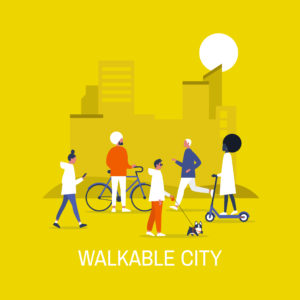Pascal’s Wager and Face Masks

Wear a mask!
I like to think of Blaise Pascal (1623 — 1662), the French mathematician, as the western world’s first practitioner of Twitter. His collected Pensées were brief, enigmatic thoughts about mathematics, religion, and philosophy. Collected after his death, they read like tweets from the 17th century (though they were intended to be a much more comprehensive defense of religion).
In the Pensées, Pascal made his famous wager. We all bet with our lives on whether God exists or not. We can live as if God exists and practice the traditional forms and virtues of religion. Or we can do the opposite and ignore our religious duties, assuming that God does not exist. If we live as if God exists and we’re right, then the rewards are infinite. If we’re wrong, the loss is finite. Indeed, it’s quite small – we’ve wasted some time in church and in prayer. Thus, Pascal argues, it’s only rational to live a pious life. The wager is heavily stacked to that side.
I’m applying the same logic to face masks in the time of coronavirus. I don’t know if face masks will protect me – or those around me – from a viral infection. Most scientists seem to believe that masks help dampen the disease’s spread. But some scientists take vigorous exception and argue loudly the face masks do no good at all.
So, who’s right? Like most Americans, I’m not qualified to judge. But I am qualified to apply Pascal’s wager. Let’s say that I bet that face masks offer useful protection and decide to wear them regularly. Now let’s guess that I’m right; I win the wager. What have I gained? The face mask may have protected me from a nasty and long-lasting infection. Indeed, since I’m over 60 and have some underlying health conditions, the mask may well have saved my life.
But what if I’m wrong? What have I lost? A few dollars for a supply of masks and a few hours of discomfort while wearing them. In other words, not much. So, the bet is stacked. I could gain a lot. But even if I lose, I don’t lose much. As Pascal might conclude, it’s only rational to wear a mask.
And, when I’m not wearing a mask, I’ll reflect on one of Pascal’s most famous tweets: “All of man’s problems stem from his inability to sit still in a room.” Pascal sums it up pretty well. Either sit still in a room or wear a mask. Thank you, Blaise.
Spot The Fallacy

I recently saw an ad for Progressive Insurance that says, “Drivers who save with Progressive, save $796 on average.”
Now I like Progressive. And I love Flo. So, I’m sure that the statement is true. I’m sure it’s based on fact.
But it also entails a logical fallacy. If you don’t spot the fallacy, you may easily assume that the average savings for all drivers who switch to Progressive is $796. That would be a mistake.
This is a good example of the survivorship fallacy. We only examine cases that “survive” a certain threshold. In this case, the threshold is drivers who save. What about drivers who didn’t save?
Let’s say that we have 1,000 drivers who saved money. In fact, they saved a total of $796,000. On average, they saved $796 each.
Now let’s say that another 1,000 drivers saved nothing. Now we have 2,000 drivers who saved a total of $796,000. On average, they saved $398 each.
When we consider those people (or cases) that didn’t survive the threshold, the numbers change dramatically. You might hear an investment company say, “Investors who have stayed with us for ten years, made an average of 7.3% per year.” The threshold is stayed with us for ten years. Your question should be, “Well, what about those who didn’t stay for ten years?”
The survivorship fallacy doesn’t just affect numbers; it also affects qualities. Let’s say a prominent management journal publishes an article that proclaims, “The Ten Most Innovative Companies In The World Do These Three Things.” The threshold for selection is the ten most innovative companies (however that is measured). It’s quite possible that many other companies do the same three things but aren’t nearly as innovative. Since they didn’t survive the selection criterion, however, we don’t consider them.
What’s the moral? When you see an ad, put your critical thinking cap on. You’re going to need it.
Walking Up The Economic Ladder
 Want your kids to have a better life than you do? Move to a more walkable neighborhood.
Want your kids to have a better life than you do? Move to a more walkable neighborhood.
That’s the upshot of a study recently published in American Psychologist. The authors, Shigehiro Oishi, Minkyung Koo, and Nicholas Buttrick, correlated neighborhood walkability with intergenerational upward social mobility. The basic finding: kids who grow up in walkable neighborhoods are more likely to move upward – as compared to their parents – than kids who don’t live in walkable neighborhoods.
The authors begin by noting that “Although upward mobility is generally in decline in the United States …it is easier to get ahead in some parts of the United Sates than in others.” Kids growing up in Pittsburgh, for instance, are much more likely to rise from the bottom 20% (as kids) to the top 20% (as adults) than are kids growing up in Charlotte, North Carolina.
Why would that be? Previous research had identified five factors associated with socioeconomic fluidity for a given area. These are “1) less residential segregation, 2) less income inequality, 3) better primary schools, 4) greater social capital, and 5) greater family stability.” (Social capital is a measure of community participation, including the proportion of people in a given area who vote, volunteer, and otherwise engage in community activities).
Oishi, Koo, and Buttrick accept the “Five Factors” and ask an additional question: does the walkability of a neighborhood also contribute to social fluidity? The authors conducted four different studies to answer this question. Here are some of the top-level findings.
- Comparing 389 commuting zones with walkability ratings from walkscore.com, “showed that upward social mobility was substantially higher in more walkable commuting zones than in less walkable commuting zones.” (r = .390, p<.001)
- But, wait. Maybe it was the Five Factors as opposed to walkability per se. The researchers held the Five Factors constant and found that “walkability explained 11% of additional variance uniquely” beyond the Five Factors. (R2 rose from .41 to .52).
- But, wait. Maybe walkable areas are also more liberal politically – and the liberal policies promote social fluidity as opposed to walkability. Or maybe it’s because walkable areas are healthier and healthier people are more socially fluid. Nope. The researchers held these variables constant (as well as several others). “Overall, walkability was a robust predictor of upward social mobility beyond factors previously used….”
- Why, then would walkability promote social fluidity? One finding is that people have less need for cars in walkable neighborhoods. People without cars can compete effectively for jobs in a wider geographic area.
- Additionally, walkability seems to promote a “sense of belonging” in a neighborhood. The researchers found that these feelings of belonging were “themselves associated with upward social mobility”.
- Does it only work in America? Does this reflect the individualism of America or is it also present in more collectivist societies? The researchers collected data from South Korea, which they describe as a “vertical, collectivist culture”. The finding: “… frequency of walking was indeed associated with a greater sense of belonging, which was in turn associated with upward social mobility.”
This study raises bigger, broader questions as well. Numerous commentators have noted that upward mobility in the United States has declined precipitously over the past 50 to 75 years. Baby boomers may be the last generation to do broadly better than their parents.
This time frame corresponds to the growth of suburbs and our increasing dependence on cars. We can surmise that more people today live in non-walkable areas than they did, say, in 1950. Perhaps this migration explains why upward mobility is declining. As we spread out horizontally, we grow isolated and have less sense of belonging. Though the automobile is a vehicle for geographic mobility, it may well be an obstacle to social mobility.
In the course of writing this article, I discovered a great website: walkscore.com. The site provides walkability ratings on a scale of 0 to 100. For instance, our home in Denver gets a walkability rating of 51. We can walk to some restaurants and are close to some pretty good public transportation. By contrast, our little apartment in Brooklyn gets a walkability score of 99. We could easily live there without a car. Check it out. It may change the way you view your neighborhood.
What Good Is History?
All humans want to connect the dots. We want to explain why something happened – or will happen — by linking events through time. A caused B caused C and that will cause D. When we do this in the past, we call it history. When we project it into the future, we call it politics.
We want to connect the dots because we deeply desire a sense of control. If we can explain why something happened in the past, we believe that we can control it in the future. If X causes Y and we don’t want Y to happen again in the future, then we can work very hard to eliminate X. We can control the future because we can explain the past in mechanistic terms.
The past, however, is a very rich source of causes and effects. It may be that X causes Y in some circumstances. In other cases, perhaps P causes Y. In still other cases, the combination of X, P, and Z causes Y – but only if X, P, and Z occur in a certain order. If we look hard enough, we can use history to prove anything we want. Liberal historians find liberal causes. Conservative historians find conservative causes. To paraphrase Ernest Rutherford, this isn’t physics, it’s stamp collecting. One side collects red stamps; the other side collects blue stamps.
We often underestimate the role of chance in the shaping of events. As Hans Zinsser pointed out in Rats, Lice, and History, a lot of stuff happens by accident and stupidity. The right person is in the right place at the right time and we have a victory. The right person is not in the right place at the right time and we have a tragedy. Stuff happens for no apparent reason.
Yet we still have a need for control. So we make stuff up. The fancy term for this is confabulation. Wikipedia defines confabulation as a “memory error defined as the production of fabricated, distorted, or misinterpreted memories about oneself or the world, without the conscious intention to deceive.” It’s not a lie; it’s an illusion.
We used to think that confabulation was a sign of mental illness. Today, we believe that every human does it. It’s a simple way to deal with a reality that we can’t explain or control.
The French philosopher, Henri Bergson, developed the related idea of “retrospective illusion”. As we “…consider our actions in the past, we have the illusion that they could not have developed in any other way. At the moment, however, our actions seem indeterminate.” We see the past as an eternal chain of causes and effects that could not have happened in any other way. According to Bergson, it’s an illusion. We see the path of history clearly. What we don’t see is how it might have lurched in a different direction because of some random event. (Bergson’s concept is also known as retrospective determinism).
Even the best histories by the best thinkers must necessarily omit most of reality. As Mark Twain wrote, ““In the real world, the right thing never happens in the right place and the right time. It is the job of journalists and historians to make it appear that it has.” We simplify the real world so we can comprehend it and control it. As we simplify, we also make mistakes. Perhaps Hegel (pictured) was right: “History teaches us nothing except that it teaches us nothing.”
Spotting Random Fraud
Let’s say we have an election and 20 precincts report their results. Here’s the total number of votes cast in each precinct:
3271 2987 2769 3389
2587 3266 4022 4231
3779 3378 4388 5327
2964 2864 2676 3653
3453 4156 3668 4218
Why would you suspect fraud?
Before you answer that, let me ask you another question. Would you please write down a random number between one and 20?
Asking you to write down a random number seems like an innocent request. But the word “random” invokes some unusual behavior. It turns out that we all have in our minds a definition of “random” that’s not quite … well, random. Does the number 17 seem random to you? Most people would say, “Sure. That’s pretty random.” Do the numbers 10 and 15 seem random to you? Most people would say, “No. Those aren’t random numbers.”
Why do we have a bias against 10 and 15? Why do we say they aren’t random? Probably because we often round our numbers so that they end in zeros or fives. We say, “I’ll see you in five minutes (or 10 minutes or 15 minutes)”. We rarely say, “I’ll see you in 17 minutes”. In casual conversation, we use numbers that end in zeros or fives far more often than we use numbers that end in other digits. Because we use them frequently, they seem familiar, not random.
So, if we want numbers to look random – as we might in a fraud – we’ll create numbers that fit our assumptions of what random numbers look like. We’ll under-represent numbers that end in fives and zeros and over-represent numbers that end in sevens or threes or nines. But if the numbers are truly random, then all the digits zero through nine should be equally represented.
Now look again at the reported numbers from the precincts. What’s odd is what’s missing. None of the twenty numbers end in five or zero. But if the numbers were truly random, we would expect – in a list of 20 — at least two numbers to end in zero and two more to end in five. The precinct numbers are suspicious. Somebody was trying to make the numbers look random but tripped over their own assumptions about what random numbers look like.
Moral of the story? If you’re going to cheat, check your assumptions at the door.
By the way, I ask my students to write down a random number between one and 20. The most frequent number is 17, followed by 3, 13, 7, and 9. There is a strong bias towards odd numbers and whole numbers. No one has ever written down a number with a fraction.
